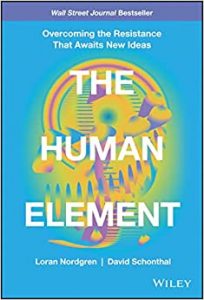Perspectives
What Digital Health Entrepreneurs Can Learn From David Schonthal and His New Book, The Human Element
 7wireVentures Operating Partner and Professor of Innovation & Entrepreneurship at Kellogg School of Management, David Schonthal recently published his Bestselling book, The Human Element, co-authored by fellow Kellogg Professor of Management and Organizations, Loran Nordgren. The book explores the four Frictions (Inertia, Effort, Emotion, and Reactance) that operate against new ideas and innovation and outlines how entrepreneurs can overcome resistance to innovation and change.
7wireVentures Operating Partner and Professor of Innovation & Entrepreneurship at Kellogg School of Management, David Schonthal recently published his Bestselling book, The Human Element, co-authored by fellow Kellogg Professor of Management and Organizations, Loran Nordgren. The book explores the four Frictions (Inertia, Effort, Emotion, and Reactance) that operate against new ideas and innovation and outlines how entrepreneurs can overcome resistance to innovation and change.
We had the pleasure of sitting down with David to learn more about the inspiration behind the book and hear his key takeaways for digital health entrepreneurs.
You’re an Operating Partner, Professor, Consultant, Author, and so much more! How have the unique skillsets and experiences you’ve garnered in each of these positions supported and impacted each other?
I’m a big believer in the benefit of analogous inspiration and of looking outside of your own backyard for inspiration about doing things differently. All my roles are focused on innovation, they just approach it through different lenses. And honestly, I get better at the craft of innovation because I have exposure to all these different domains. From the academic world, I learn why things work the way that they do. From my work with entrepreneurs, I learn about what’s possible. Through consulting, I learn how premier organizations around the globe are bringing innovations to market. All these roles are mutually reinforcing in a unique way.
You just co-authored a book, The Human Element, with Loran Nordgren, which explores the four Frictions that operate against innovation. What inspired you and Loran to write the book?
 Loran and I have worked together for years at Kellogg and we’re both fascinated by why good ideas fail to get traction in the world. For Loran, the interest stems from a psychological perspective and how the human mind makes us resistant to change. For me, it’s from an entrepreneurship perspective and understanding how we get past these habits of the mind to ensure useful, new products and services get in the hands of the people who need them most.
Loran and I have worked together for years at Kellogg and we’re both fascinated by why good ideas fail to get traction in the world. For Loran, the interest stems from a psychological perspective and how the human mind makes us resistant to change. For me, it’s from an entrepreneurship perspective and understanding how we get past these habits of the mind to ensure useful, new products and services get in the hands of the people who need them most.
The Human Element is a book neither of could have written independently. What makes this book work, and what has made it successful, is our different vantage points on the same phenomenon.
Can you walk us through each of the four Frictions you explore in the book and how you came to identify them?
The metaphorical question we pose at the beginning of the book is, “what makes a bullet fly?”. And not only what makes a bullet fly but what allows a bullet to travel a great distance while maintaining sharp accuracy? The common answer you’ll hear is gunpowder which provides thrust and forward momentum. This isn’t necessarily an incorrect answer, but it’s an incomplete one. While speeding through the air, a bullet encounters many forces working against it – wind resistance, drag, gravity. This is an apt metaphor for innovation.
We believe when we come up with new ideas, if we give them enough power, enough force, enough thrust, that people will say “yes”. Yet we fail to recognize there are many hidden forces – just like gravity and drag – working against our novel ideas on their way to market.
Together, Loran and I identified four headwinds that stand in the way of getting innovative ideas adopted.
The first is Inertia, our overwhelming allegiance to the status quo. We intellectually understand there is a better way to do something, but the human mind craves the familiar. We are constantly evaluating new ideas relative to what’s known and comfortable. And the greater the departure from the status quo, the stronger the Inertia will be. We don’t always recognize that when we highlight the newness of our innovation what we’re really highlighting is how unfamiliar it is to our intended audience.
The second is Effort, which is the amount of energy – both physical and cognitive – required to get people to change. The more complicated and ambiguous the change, the harder it is for people to agree to it. We not only need to figure out how to get people to believe our idea is attractive but also how to lay out a clear and easy path to adoption. This is something we need to think about throughout the entire lifecycle of a new product, initiative, or change, not only in the early stages.
The third is Emotion, or the undesired feelings our new ideas cause in others. Anytime we’re asking someone to change, we must anticipate there will be a level of anxiety, trepidation, and even fear that accompanies it. But because people don’t always wear their emotions out in the open, this is a Friction that must be discovered. We need to spend time talking to our customers, particularly those who recently hired or fired us, to understand their hesitations and the anxieties that stood in the way of easy adoption – and more importantly – what helped them overcome it. It’s only once we understand where these emotional Frictions are lurking that we can begin to remedy Emotion’s power to stop innovation in its tracks.
The last force is Reactance, or the Friction that pushes against a new idea imposed on us. As human beings, we have an overwhelming aversion to being changed by others. We will resist change we feel is forced on us with equal if not greater force. This stems from our desire to be autonomous and have freedom over our own decisions. Instead of telling consumers what to do, we need to invite them to participate in idea creation. We must ask ourselves, “How do we engage them in self persuasion versus directional persuasion?”
Why do digital health startup entrepreneurs need to understand these frictions?
Many entrepreneurs across digital health don’t even recognize that these Frictions are present. They wonder why none of their customers are converting, or why no one is adopting, or engaging with a piece of technology or a new way of managing a disease. Our instinct is if someone is not saying “yes”, or not engaging with our product, that there is something wrong with the product itself. We overwhelmingly feel that if we just get the mix of features and benefits right people will eventually see its value.
Instead of focusing on amplifying the goodness of an idea by adding features or changing the price, entrepreneurs need to change their orientation to minimizing the Frictions standing in the way of adoption.
When done well it works beautifully – and it’s often far more efficient and cost effective to focus on reducing Friction than on adding Fuel. Something as simple as adjusting the language used when speaking about a new idea is a small change that can pay huge dividends.
What is one thing you wish you knew before writing a book?
Writing a book takes a lot of discipline, and I am not a disciplined person when it comes to time management. Loran would wake up at five o’clock every morning and write. I’d have to wait for inspiration to call upon me, but then I’d sit down and crank out content for two straight days.
If you had to pick a topic for your next book, what would it be?
We deliberately wrote The Human Element making sure that the content was broadly applicable and that it wasn’t just about one domain. We drew examples from a variety of arenas, but we don’t dive into any one particularly deeply. Perhaps our next book will be a version of The Human Element specifically focused on one sector – like healthcare – because there is a lot more to explore and highlight with the application Friction Theory.
If you weren’t a VC, a professor, or an author, what would you be?
A drummer in a rock band! Right now, it’s just hobby, but if I could, I’d be a drummer full time and get better at music.